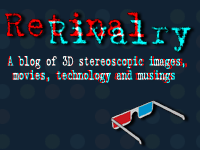In January, I attended the annual Consumer Electronics Show (CES) convention in Las Vegas, to see the latest developments in 3DTVs. With all of the hype surrounding 4K television and OLED curved screens, there wasn’t much new to see in the way of 3-D displays. LG, the South Korean electronics manufacturer, continued to show strong support for passive-polarized 3DTVs, but many other TV makers chose not to exhibit any 3-D content at their booths. The only new developments in the 3-D world seemed to be several companies showcasing glasses-free 4K 3DTV, most using the Dolby 3-D system for their displays. For what it’s worth, the Dolby 3-D TV is essentially a rebranding of the same 3-D technology that Phillips has been demonstrating since 2008. There is little new about it, save for the increased resolution of the underlying TV.
Auto-stereoscopic displays of this size operate differently than a standard 3DTV, in that they use a lens system similar to a lenticular postcard to allow the viewers eyes to see left and right views simultaneously. These TVs do not just present left and right pairs - they require multiple images in between the extremes to essentially fill the area under each lenticule. The inherent problem with this method is the limited viewing angle of the lenses, which leads to the limited “sweet spots” from which the 3-D can be viewed. The wider the viewing angle of the optics, the wider the sweet spot, but at the same time, more images are needed to create the spread from left to right. And lenticular displays DO have limitations on the amount of parallax that they can accurately present before the image degrades and can no longer be seen correctly in 3-D. Very deep 3-D, both in positive (into screen) and negative space (off screen) is impossible with the current tech.
The current wave of auto-stereoscopic TVs have a dirty little secret that isn’t well publicized - in order to create the multiple views, the manufacturers are throwing away the original stereo and synthesizing new depth from a single view. In some cases, this means preparing new content ahead of time, as in Dolby’s demo, which featured Dolby’s in-house conversions of 3-D content within the parameters that work for their TV - and I have spoken with several of the content creators who are disgusted that Dolby has destroyed their stereoscopic intent without noting that the 3-D has been modified from it’s original format. In the case of some other glasses-free TVs, they are using an “on the fly” conversion algorithm to take the left eye from a 3-D BluRay and synthesize a new right eye with interpolated in between images. Again while there is depth, the original artists choices are “thrown out” with the right eye view.
Ultimately, glasses-free 3-D television is not ready for consumer use, and is still many years away from practically presenting original 3-D content as the filmmakers intended. There is some great research being done, and I have seen several experimental displays that utilized arrays of projectors (between 75 and 250 HD projectors) to create screen-spanning 3-D with no sweet spots, but these only work with rendered CG content. Computing power may eventually reach a point where 75 discreet views can be encoded/decoded/and synthesized from each frame of a media file, but its not happening in 2014.
Thursday, March 6, 2014
Subscribe to:
Posts (Atom)
